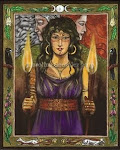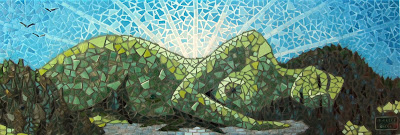Thursday, April 28, 2016
Airmid, Celtic Goddess of Healing, Plants and Herbs
Since the Spring season is upon us and the snow is melting away (for some) I wanted to write about a Goddess associated with plants and herbs.
Just in time for your Spring/Summer gardening! Airmid was a Celtic Goddess of the healing arts especially dealing with herbs and plants. She was the daughter of Dian Cecht who was the God of Medicine and chief physician to the Tuatha de Danann, the Gods of Ireland. Airmid had four brothers Miach, Cian, Cu and Cethe who also followed the path of healing and medicine.
The Tuatha de Danann went to war with the Fir Bolgs when they invaded Ireland.
The king of the Tuatha de Danann, Nuada, was injured in battle and his arm had been severed. According to the laws it was said that no man could be king whose body was not whole, so Nuada immediately called on his physician, Dian Cecht. The physician brought his daughter Airmid and his son Miach with him since they were both skilled healers.
Dian Cecht had planned to reconstruct a new arm for Nuada made of silver but since Airmid was known for her regenerative skills she was able to create an arm made of human flesh.
Miach was known for his surgical skills and he was able to attach the new arm to Nuadas body so that it looked like he had never lost an arm in the first place. So great was Miachs surgical skills that his father became jealous and in a fit of envious rage he grabbed a sword and cut off Miachs head.
Airmid was beside herself with grief after losing her brother.
She buried him and made a cairn of stones over his grave. She visited his grave to mourn his loss everyday for a year. Than one day when she went to sit at his grave she came upon 365 different herbs growing on top and all around his burial site. She laid out her cloak to gather all the herbs and as she gently plucked them from the fertile earth they whispered their unique healing properties to her. There was an herb for each joint, organ and bone in the body.
Her father Dian Cecht, still jealous of his sons vast knowledge, found Airmid and overturned her cloak scattering the herbs to the wind so that no one but she would know of the healing herbs secrets.
Thankfully, Airmid had already committed everything to memory and could regrow all the herbs to continue her and her brothers healing work. Airmid was called upon when men and women were hurt during battle. She was also said to be a healer for the fairies and other magical creatures of the forests and mountains of Ireland.
Airmid can be called upon today for any healing work you are doing.
Or any herbal medicine preparations. She can also be called on while you're gardening and planting as she will watch over the plants and lend them her healing powers and magic.
So, have you ever worked with Airmid?
Beautiful art courtesy of Cheryl Yambrach
Thursday, April 21, 2016
Goddess of the Mountains
There are many deities associated with mountains all over the world.
From Europe, Tibet and the America's, mountain deities have their place in mythology. Mountains are very ancient and primal earth structures. They're beautiful and awe-inspiring and at the same time they can also be terrifying especially for those who are afraid of heights. They were considered to be sacred by many different ancient (and modern) cultures.
In Tibet the goddess Miyolangsangma was a Goddess of mountains.
She lived at the top of Mount Everest and gave protection to those who climbed her mountain. She had five sisters and each of them had a mountain. She is often depicted riding a tiger and holding a sacred flower. Artemis, Greek Goddess of the hunt, was also associated with mountains. She was a protector of nature and a huntress and would run through the forests of the mountains hunting game.
Aitna, daughter of Gaia and Uranus, was also a Greek Goddess of mountains.
She was the Goddess of the volcanic Mt. Etna in Sicily. Pachamama, Incan Goddess of the earth, was a Goddess of mountains. She was said to live in the Andes mountains in the form of a dragon. When she moved she is reported to have caused earthquakes. The Cailleach, Celtic Crone Goddess of Winter, was known as the Mother of Mountains. She had white hair the color of a snow covered mountain.
Skadi, a Norse Goddess, is said to live in the highest regions of the mountains where the snow never melts.
She is often depicted with her snow shoes, skis and bow and arrow. She was known as a giantess and huntress Goddess. Native American tribes in the Pacific Northwest believed that evil spirits inhabited the mountains. They believed that the mountains were Gods but before they were Gods they believed they were people.
Mount Rainier in modern day Washington state was said to be a large woman at one point who lived west of Puget Sound in the Olympic Mountains.
She lived there with her husband who had two wives. They fought with each other constantly so the woman left the Olympic Mountains with her son and went to the open plains out east. There they settled and she became Mount Rainier and her son became Little Tahoma Peak.
There is much myth and magic surrounding mountains.
Some natural settings and events stop me in my tracks because of their sheer beauty. Mountains are one of these structures.
So, what's your favorite natural setting?
~ Beautiful artwork courtesy of Frances Green
Thursday, April 14, 2016
Honoring the Goddess the Creative Way
The Goddess Mandala Coloring Book is finished and available for purchase!
This project was definitely a labor of love and a beautiful journey. It's been so great to be able to connect with each Goddess through each mandala that was created. Many of the Goddess mandalas were inspired by the Goddesses you asked for, so I also feel connected to all of you throughout this journey as well. Thank you for your continued support along the way!
I wanted to color in one of the mandalas from the book to give you some inspiration.
To follow along head over to Amazon to get your copy of the coloring book. The Goddess I chose to color is the Sumerian Goddess Inanna. The colors I chose for this mandala are shades of blue, green, purple, yellow and hints of red. I wanted to use rich gemstone colors to represent Inanna because to me those colors signify her deep beauty. Some of the shades of blue and yellow I chose are also the same colors of blue and yellow that can be found on Ishtar's Gate. This was once the eighth gate to the inner city of ancient Babylon.
I started with the wings and I used three shades of blue.
Starting with a dark violet blue on top, cerulean blue in the middle and a light aqua on the bottom. I chose yellow for her crown and for the stars and decided to use a violet color to go around her. This makes the yellows and light blues really pop! The seven pointed stars that surround her are known as Inanna's Star or the Evening Star which symbolizes the planet Venus. For these I chose to color the same shades of blue that are in her wings.
For the next color around her I chose the bright, light aqua and to go around that color I chose the violet again to help make the aqua pop.
I try to stay with the same color themes throughout. It's best to use complementary colors (or shades of complementary colors) to go around each other. These make the individual colors pop. For example the violet and light aqua can be seen as complementary because they are both variations from the green and red family which are complementary colors. For the Sumerian style owls and lions I chose yellows, browns and blues. The owls wings are the exact same colors as Inanna's wings.
To finish off the outside part of the mandala I chose yellow which is a complementary color of purple.
I really wanted the Goddess figure in the middle to pop so I chose that brilliant, light aqua again. And a crimson red to color the border around her. Staying with the complementary color families of green and red. I also used hints of grass green to color the outside border of her as well as the snakes.
For the mandalas in this book I recommend using colored pencils.
You may use marker but make sure to put something thick like a piece of cardboard between each page so the marker doesn't bleed through. There are 28 mandalas total in this book with several Goddesses from around the globe. Many of the mandalas in this book can be found in my etsy shop but not all of them. Some of them are made specially for this book like this Inanna mandala.
So, what colors would you choose for this mandala? Let me know in the comments!
Subscribe to:
Comments (Atom)








